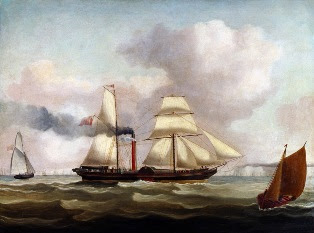In this blog, and later on my website, I have dealt several times with single-ship actions during the Age of Fighting Sail (see links at the end of this article), the protagonists being mainly British and French, though the Americans do figure in 1812-15. In most cases British victory over the French seems to have been all but pre-ordained, for the Royal Navy had reached a peak of professionalism in this period and the French officer corps had suffered badly in the revolution, a setback from which it never fully recovered. It is therefore somewhat of a surprise to learn not only of a French vessel capturing a British one in a single-ship action, but also that she was significantly smaller and less powerful.
 |
| The climax of the action. Bayonnaise (R) rams Ambuscade and the latter's mizzen falls Painting by Jean Francois Hue, 1751-1823 |
The Bayonnaise was a French 24-gun corvette, launched in 1793. Ship-rigged (i.e. with three masts), of 580 tons and 125-ft. length, she was armed with 24 eight-pounders and four light “obusier”. The latter were short-barrelled, close-range weapons, the French answer to the British carronade, and of use only when ships were lying close together, ideally hull-to-hull. Her normal crew was about 220. Designed originally as a privateer, she was taken on the French Navy while still on the stocks. Her light armament fitted her well for a privateering, commerce-raiding role, but was likely to put her at a severe disadvantage if she encountered any larger vessel.
HMS Ambuscade was, by contrast, much more powerful, a 32-gun fifth-rate frigate which had seen successful service against the French in the American Revolutionary War. Though her dimensions were generally similar to the Bayonnaise , and though she carried a similarly sized crew, her armament was considerably heavier – 26 twelve-pounders, a total of eight six-pounder bow and stern chasers, four eighteen-pounder carronades on the quarterdeck and two on the forecastle. In any ship-to-ship action between the two vessels the Bayonnaise might have been expected to have no chance of survival.
From August 1798, at a time when the Royal Navy’s blockade of the French coast was becoming ever more effective, Ambuscade, commanded by Captain Henry Jenkins, was ordered to patrol off the French Atlantic coast. At dawn on 14th December, when she was cruising off the Gironde estuary, and expecting to meet HMS Stag, she sighted a sail. Assuming this to be the Stag, she steered closer. The newcomer was in fact the Bayonnaise which, significantly as it later proved, was carrying a 40-man army detachment in addition to her own crew. The French ship, recognising that she was outsized and out-gunned, went about and fled. A stern-chase ensured and it was not until noon that the range closed sufficiently for the first shots to be fired.
Bayonnaise was to take ferocious punishment in the next hour, with serious damage to hull, masts and rigging. The action might have ended when Ambuscade crossed Bayonnaise’s stern. This was the most vulnerable part of any sailing man-of-war, as shot crashing through the stern could run longitudinally along the entire inner decks, destroying all in their path. The manoeuvre, if successfully executed, was the deciding factor in many naval battles. It was at this moment of greatest risk that Bayonnaise’s luck kicked in. One of the Ambuscade’s 12-pounders burst, killing thirteen around it and destroying the vessel’s boats. In the ensuing confusion Bayonnaise headed south and a new stern chase developed. Ambuscade, recovered from her set-back, drew level in mid-afternoon –when on this winter’s day only a few hours of daylight still remained.
 |
| The moment of ramming - note damage to sails As represented by naval artist Antoine Roux (1765-1835) |
The extra men Bayonnaise carried – soldiers, accustomed to handling muskets – now proved decisive. A withering fire was directed on Ambuscade’s deck, so many of her officers being wounded that only a single lieutenant was left in command. Bayonnaise too was taking casualties – Captain Richter had an arm shot off –but the advantage now lay with her. French seamen and soldiers clambered across the bowsprit on to Ambuscade and a savage melee developed. Bayonnaise’s new-found luck continued, for a powder charge exploded on Ambuscade’s quarterdeck, inflicting yet more casualties. The fighting continued for another half-hour, but numbers told. When Ambuscade’s colours were struck it was by her purser, the last Royal Navy officer still in action.
The butcher’s bill for this action was 15 killed and 39 wounded on Ambuscade while Bayonnaise had 25 killed and 30 wounded. The captains of both vessels were among the wounded, and many other officers beside. It should be borne in mind that “wounded” often implied the necessity of amputation of limbs and that death by gangrene was a serious possibility thereafter. As was normal when a captain lost his ship, Captain Jenkins was later court-martialled, though he was exonerated, despite what many considered poor leadership and tactical manoeuvring.
Both vessels were to have active careers thereafter. Ambuscadewas taken into French service as Embuscade – wooden ships were almost infinitely repairable if they had not exploded or been sunk. She was however recaptured in 1803 by no less a prestigious ship than HMS Victory, and she resumed her old name. She had an active and successful career thereafter until she was broken up in 1810. Bayonnaise’sluck ran out in 1803, the same year in which Ambuscade/Embuscade’s turned for the better. Run down by HMS Ardent off Cape Finnisterre, her crew burned her rather than surrender.
French pride in the Bayonnaise/Ambuscade action was unbounded – probably because such victories were rare – and eminent artists of the time produced dramatic paintings of it. They convey much of the excitement and drama and some have been used to illustrate this article.
























































































































